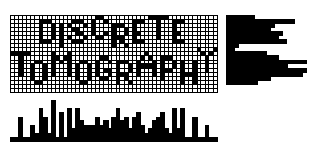DISCRETE TOMOGRAPHY WORKSHOP

25-27 August, 1997
Szeged, Hungary
Supported by the Hungarian Academy of Sciences, Hungary, and
the
National Science Foundation, USA
We
assume that there is a domain, which may itself be discrete (such as a
set of ordered pairs of integers) or continuous (such as Euclidean
space). We further assume that there is an unknown function f whose
range is known to be a given discrete set (usually of real numbers). The
problems of discrete tomography, as we perceive the field, have to do
with determining f (perhaps only partially, perhaps only approximately)
from weighted sums over subsets of its domain in the discrete case and
from weighted integrals over subspaces of its domain in the continuous
case. In many applications these sums or integrals may be known only
approximately. From this point of view, the most essential aspect of
discrete tomography is that knowing the discrete range of f may allow us
to determine its value at points where without this knowledge it could
not be determined. Discrete tomography is full of mathematically
fascinating questions and it has many interesting applications.
Participants:
USA
- Jolyon A. Browne
Advanced Research and Applications Corporation,
Sunnyvale, California
- Richard A. Brualdi
Mathematical Deptartment, University of Wisconsin,
Medison, Wisconsin
- Michael Chan
Signal and Image Processing Institute of the
University of Southern California
- Zang-Hee Cho
University of California,
Irvine, California
- Eric L. Grinberg
Temple University, Philadelphia,
Pennsylvania
- Gabor T. Herman
MIPG, Dept. Radiology, Univ. Pennsylvania,
Philadelphia, Pennsylvania
- Joop Kempermann
Math. Dept., Rutgers Univ., New Brunswick,
New Jersey
- Samuel Matej
MIPG, Dept. Radiology, Univ. Pennsylvania,
Philadelphia, Pennsylvania
- Pablo M. Salzberg
Dept. Math Comp. Sci., Univ. Puerto Rico,
Rio Piedras, Puerto Rico
- Ken Sauer
Dept. Electrical Engineering, University of Notre
Dame, Notre Dame, Indiana
- Larry Shepp
ATT Bell Laboratories, Murray Hill,
New Jersey
- Yehuda Vardi
Rutgers University, Newark,
New Jersey
- Sally L. Wood
Santa Clara University, Santa Clara,
California
- Andrew E. Yagle
University of Michigan, Ann Arbor,
Michigan
- Neal Young
Dartmouth College, Hanover,
New Hampshire
Hungary
- Barany Imre
MTA Matematikai Kutato Intezet,
Budapest
- Fejes-Toth Gabor
MTA Matematikai Kutato Intezet,
Budapest
- Hajnal Peter
JATE, Bolyai Intezet,
Szeged
- Kincses Janos
JATE, Bolyai Intezet,
Szeged
- Kuba Attila
JATE, Informatikai Intezet,
Szeged
- Kurusa Arpad
JATE, Bolyai Intezet,
Szeged
- Odor Tibor
JATE, Bolyai Intezet,
Szeged
- Pach Janos
MTA Matematikai Kutato Intezet,
Budapest
- Petho Attila
KLTE Matematiai es Informatikai Intezet,
Debrecen
- Turan Gyorgy
MTA Kutatocsoport,
Szeged
Others:
- Richard Anstee
University of British Columbia,
Vancouver, Canada
- Jose-Maria Carazo
Autonoma University,
Madrid, Spain
- Yair Censor
University of Haifa,
Haifa, Israel
- Peter Schwander
Swiss Federal Institute of Technology,
Zurich, Switzerland
- Aljosa Volcic
Dept Mathematics, University of Trieste
Trieste, Italy
Organisers:
Gabor T. Herman
Medical Image Processing Group, Department
of Radiology, University of Pennsylvania,
Blockley Hall, Fourth Floor,
423 Guardian Drive,
Philadelphia, PA 19104-6021
USA
Attila Kuba
Department of Applied Informatics,
Jozsef Attila University
H-6720 Szeged, Arpad ter 2.
Hungary
The Workshop will take place in the
Hotel Forras
Address: H-6726 Szeged, Szent-Gyorgyi Albert u.
16-24, Szeged, Hungary,
Phone: +36-62-430-130,
Fax:
+36-62-430-130/500
Previous meeting:
DIMACS Mini-Symposium on Discrete Tomography
September 19, 1994
DIMACS
Rutgers University
DIMACS sponsored a one-day mini symposium on discrete tomography.
In continuous tomography, a density f(x,y) is to be reconstructed
from its integrals over lines or sub-manifolds. In discrete tomography,
the "density" is either 1 or 0 at each point of a lattice and represents
the presence or absence of an atom at the site. Line integrals are now
line sums. Thus, if S is a finite subset of the lattice E = Z2 or Z3,
and if D is a finite set of (main) directions in E, we measure the line
sums of S along every line with a direction in D. When is S uniquely
determined? How large does D have to be to determine every convex
set S which is confined to a given box? How large does a box have
to be before uniqueness fails for convex sets? Problems of this
general type, which arise in transmission electron microscopy of
crystals, will be discussed. Related problems in geometric and in
continuous tomography will also be discussed. A tour of a lab in Holmdel
which measures the above line sums for a given crystal, S, using a
transmission electron microscope will be arranged for interested
participants.
